Long-Term Changes and Variability of Ecologically-Based Climate Indices along an Altitudinal Gradient on the Qinghai-Tibetan Plateau
Abstract
1. Introduction
2. Materials and Methods
2.1. Study Area
2.2. Data
2.3. Climate Metric Indices with Ecological Relevance
2.4. Statistical Analysis of Climatic Variables with Ecological Relevance
3. Results
3.1. Long-term Variability in Precipitation and Temperature Variables with Ecological Relevance
3.2. Distributions of the Precipitation and Temperature Variables with Ecological Relevance across Climatic Zones
3.3. Changes in the Precipitation and Temperature Variables with Ecological Relevance Along the Altitudinal Gradient
4. Discussion
4.1. Long-Term Variability in Climatic Variables with Ecological Relevance
4.2. Altitudinal Variability in Climatic Variables with Ecological Relevance
4.3. Necessity of Simulating Climatic Variables with Ecological Relevance in Ecosystem Models
5. Conclusions
Funding
Conflicts of Interest
Appendix A
Appendix A.1. Monthly Precipitation and Temperature of Various Climatic Zones
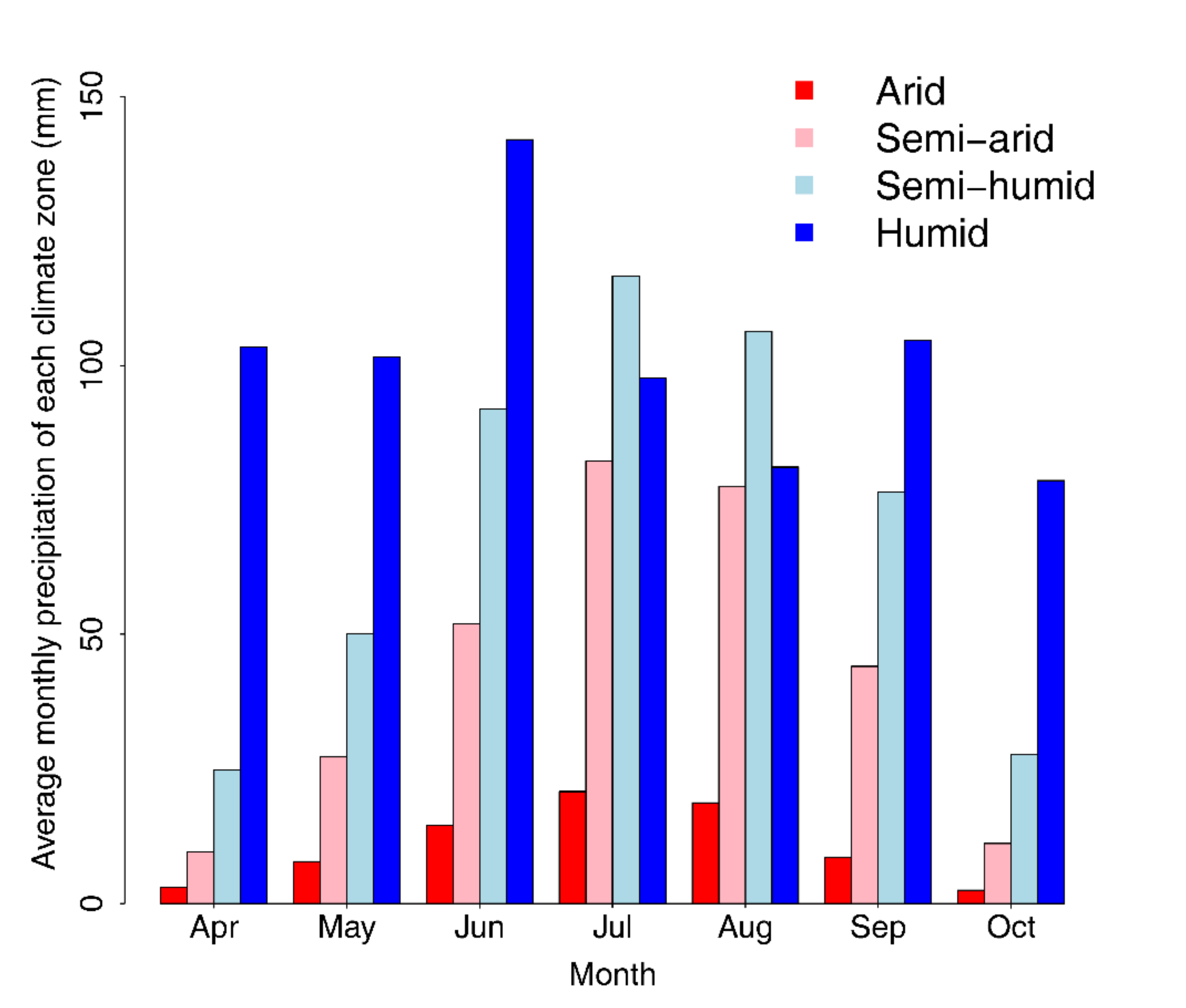
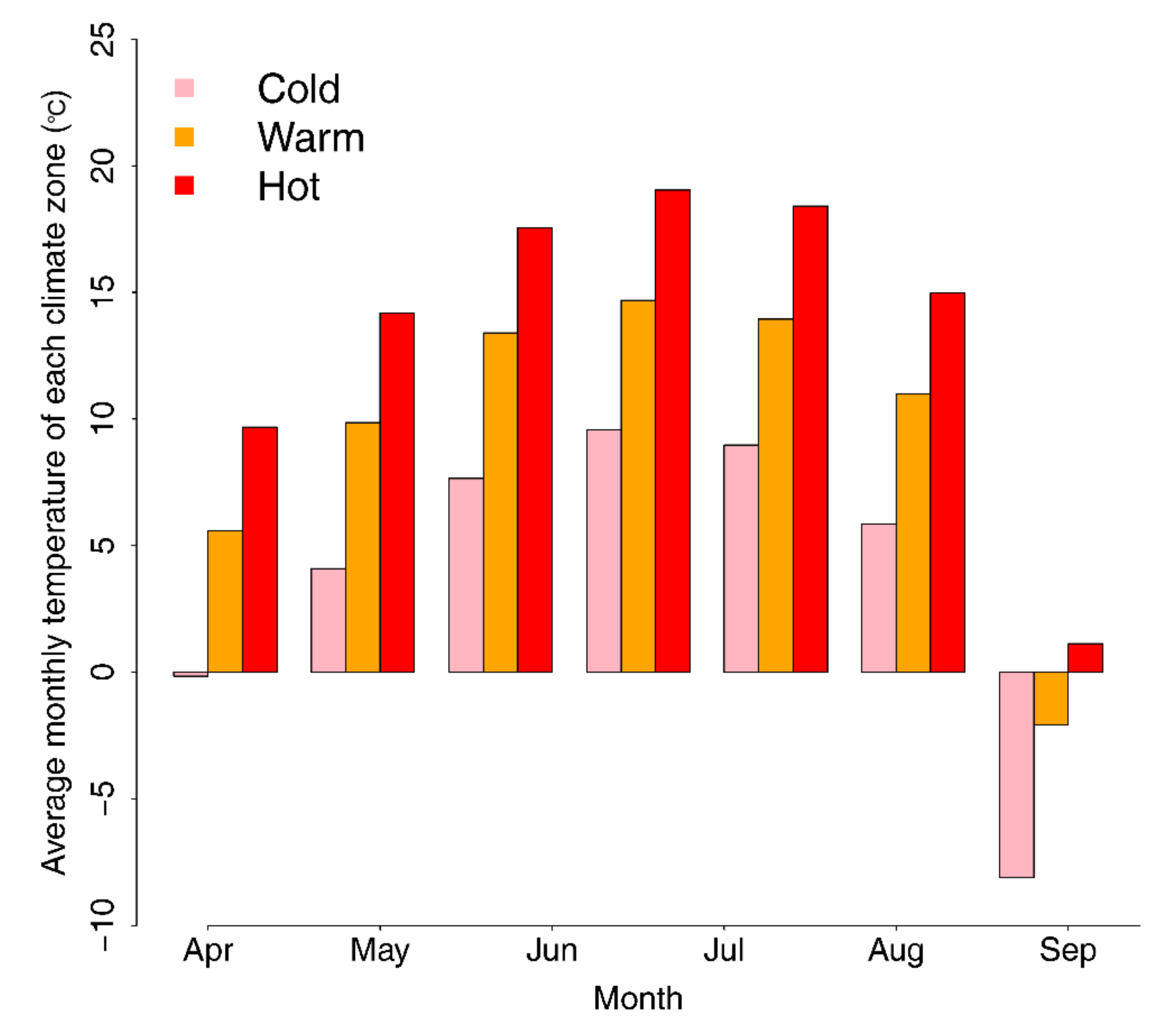
Appendix A.2. The Relationship between Daily Precipitation and Daily Mean Temperature
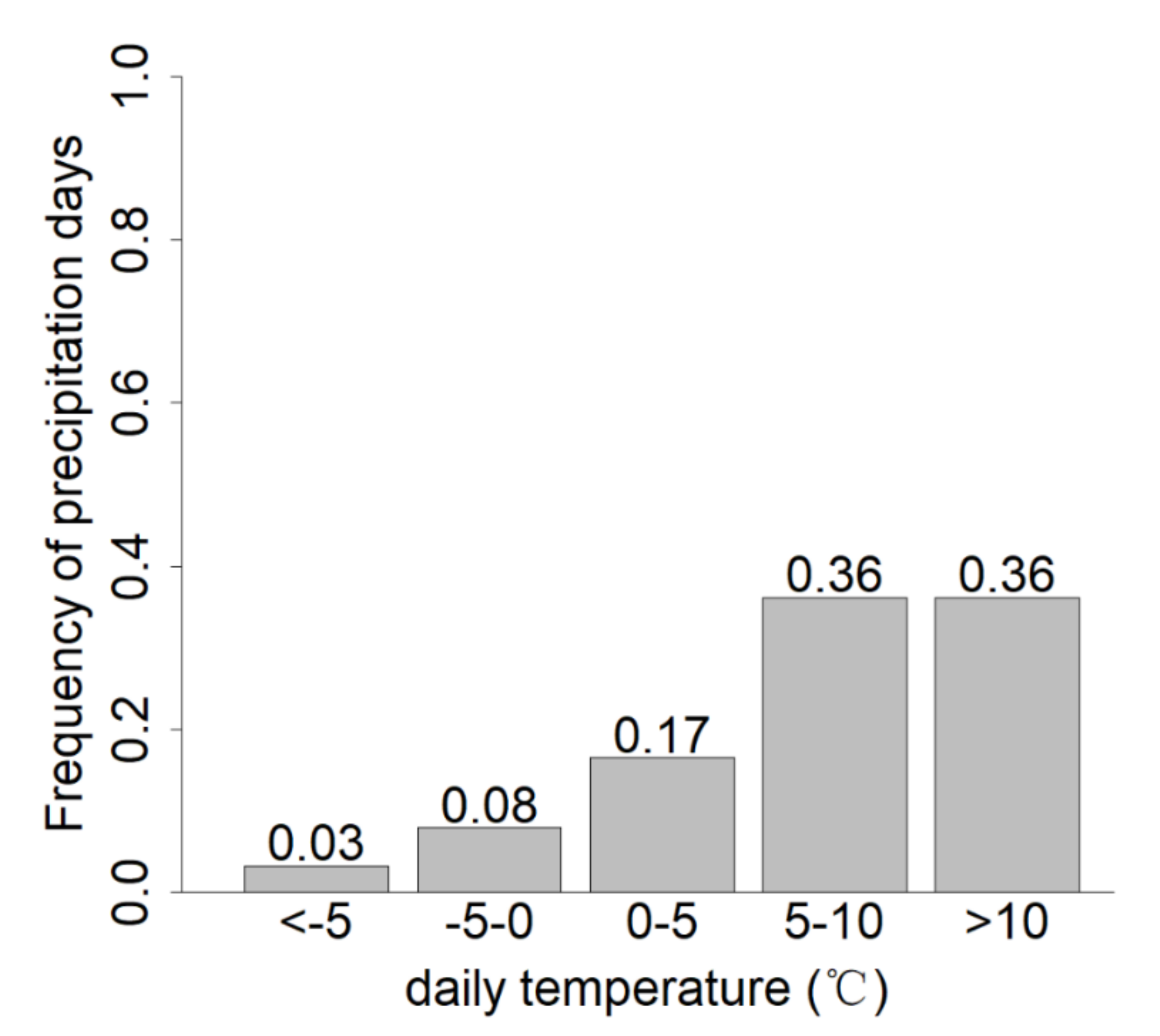
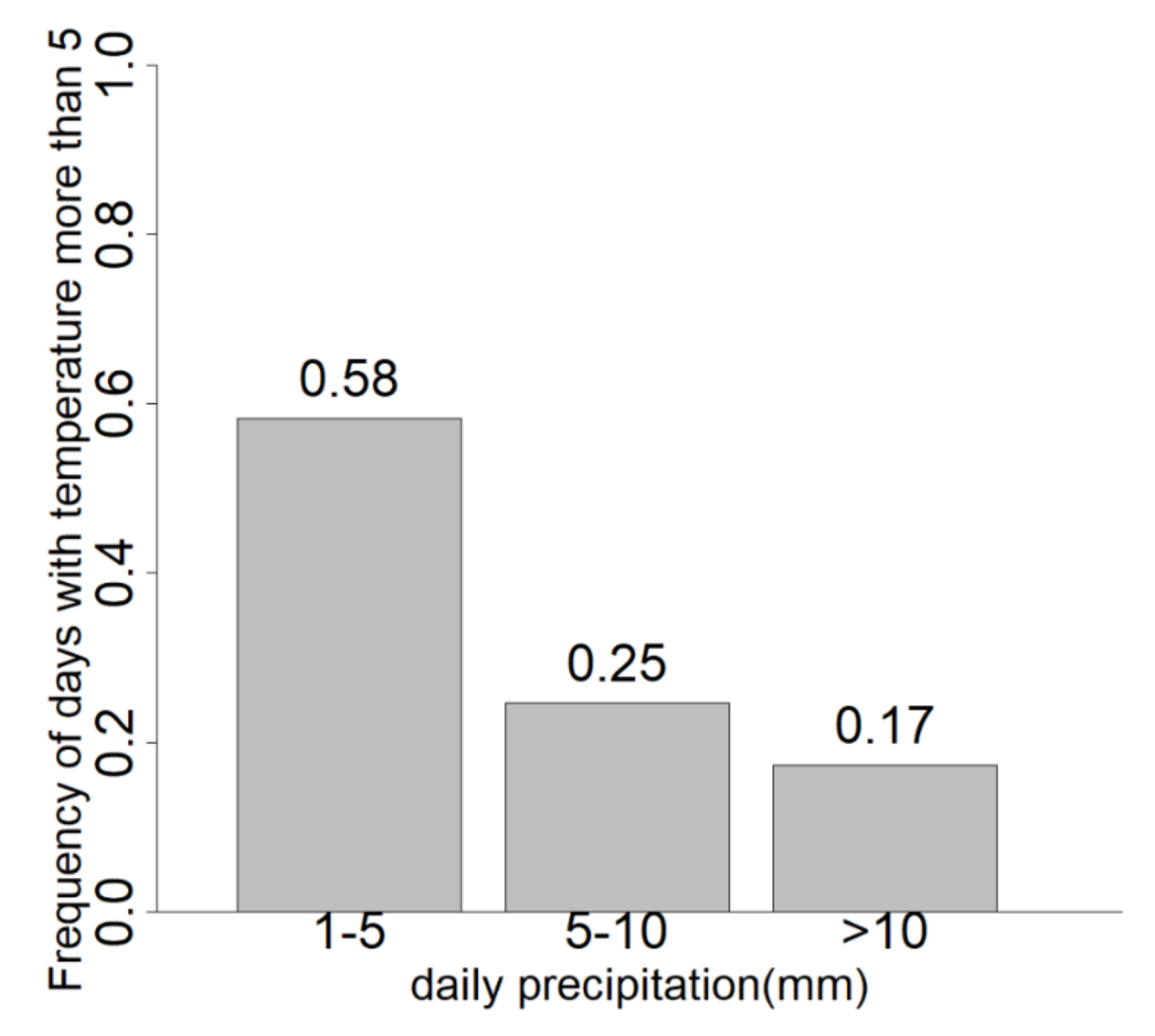
References
- Zscheischler, J.; Mahecha, M.D.; Harmeling, S.; Reichstein, M. Detection and attribution of large spatiotemporal extreme events in Earth observation data. Ecol. Inform. 2013, 15, 66–73. [Google Scholar] [CrossRef]
- Dwyer, J.G.; O’Gorman, P.A. Changing duration and spatial extent of midlatitude precipitation extremes across different climates. Geophys. Res. Lett. 2017, 44, 5863–5871. [Google Scholar] [CrossRef]
- IPCC Climate Change 2013: The Physical Science Basis: Contribution of Working Group I to the Fifth Assessment Report of the Intergovernmental Panel on Climate Change; Cambridge University Press: Cambridge, UK; New York, NY, USA, 2013.
- Paschalis, A.; Fatichi, S.; Katul, G.G.; Ivanov, V.Y. Cross-scale impact of climate temporal variability on ecosystem water and carbon fluxes. J. Geophys. Res. Biogeo 2015, 120, 1716–1740. [Google Scholar] [CrossRef]
- Harris, R.M.B.; Beaumont, L.J.; Vance, T.R.; Tozer, C.R.; Remenyi, T.A.; Perkins-Kirkpatrick, S.E.; Mitchell, P.J.; Nicotra, A.B.; McGregor, S.; Andrew, N.R.; et al. Biological responses to the press and pulse of climate trends and extreme events. Nat. Clim. Chang. 2018, 8, 579–587. [Google Scholar] [CrossRef]
- O’Gorman, P.A. Sensitivity of tropical precipitation extremes to climate change. Nat. Geosci. 2012, 5, 697–700. [Google Scholar] [CrossRef]
- Dai, A.G. Increasing drought under global warming in observations and models. Nat. Clim. Chang. 2013, 3, 52–58. [Google Scholar] [CrossRef]
- Alexander, L.V.; Zhang, X.; Peterson, T.C.; Caesar, J.; Gleason, B.; Tank, A.M.G.K.; Haylock, M.; Collins, D.; Trewin, B.; Rahimzadeh, F.; et al. Global observed changes in daily climate extremes of temperature and precipitation. J. Geophys. Res. Atmos. 2006, 111. [Google Scholar] [CrossRef]
- Xiao, M.Z.; Zhang, Q.; Singh, V.P. Spatiotemporal variations of extreme precipitation regimes during 1961-2010 and possible teleconnections with climate indices across China. Int. J. Climatol. 2017, 37, 468–479. [Google Scholar] [CrossRef]
- Ge, G.; Shi, Z.J.; Yang, X.H.; Hao, Y.G.; Guo, H.; Kossi, F.; Xin, Z.M.; Wei, W.; Zhang, Z.Y.; Zhang, X.; et al. Analysis of Precipitation Extremes in the Qinghai-Tibetan Plateau, China: Spatio-Temporal Characteristics and Topography Effects. Atmosphere 2017, 8, 127. [Google Scholar] [CrossRef]
- Reichstein, M.; Bahn, M.; Ciais, P.; Frank, D.; Mahecha, M.D.; Seneviratne, S.I.; Zscheischler, J.; Beer, C.; Buchmann, N.; Frank, D.C.; et al. Climate extremes and the carbon cycle. Nature 2013, 500, 287–295. [Google Scholar] [CrossRef] [PubMed]
- Van de Pol, M.; Jenouvrier, S.; Cornelissen, J.H.C.; Visser, M.E. Behavioural, ecological and evolutionary responses to extreme climatic events: Challenges and directions. Philos. Trans. R. Soc. B 2017, 372. [Google Scholar] [CrossRef] [PubMed]
- Smith, M.D. An ecological perspective on extreme climatic events: A synthetic definition and framework to guide future research. J. Ecol. 2011, 99, 656–663. [Google Scholar] [CrossRef]
- Sippel, S.; Zscheischler, J.; Reichstein, M. Ecosystem impacts of climate extremes crucially depend on the timing. Proc. Natl. Acad. Sci. USA 2016, 113, 5768–5770. [Google Scholar] [CrossRef] [PubMed]
- Galera, H.; Chwedorzewska, K.J.; Wodkiewicz, M. Response of Poa annua to extreme conditions: Comparison of morphological traits between populations from cold and temperate climate conditions. Polar Biol. 2015, 38, 1657–1666. [Google Scholar] [CrossRef]
- Smith, M.D. The ecological role of climate extremes: Current understanding and future prospects. J. Ecol. 2011, 99, 651–655. [Google Scholar] [CrossRef]
- Hamada, A.M. Alteration in growth and some relevant metabolic processes of broad bean plants during extreme temperatures exposure. Acta Physiol. Plant. 2001, 23, 193–200. [Google Scholar] [CrossRef]
- Schwinning, S.; Sala, O.E. Hierarchy of responses to resource pulses in arid and semi-arid ecosystems. Oecologia 2004, 141, 211–220. [Google Scholar] [CrossRef] [PubMed]
- Huang, M.; Piao, S.; Ciais, P.; Penuelas, J.; Wang, X.; Keenan, T.F.; Peng, S.; Berry, J.A.; Wang, K.; Mao, J.; et al. Air temperature optima of vegetation productivity across global biomes. Nat. Ecol. Evol. 2019, 3, 772–779. [Google Scholar] [CrossRef]
- Jiang, R.G.; Xie, J.C.; Zhao, Y.; He, H.L.; He, G.H. Spatiotemporal variability of extreme precipitation in Shaanxi province under climate change. Theor. Appl. Climatol. 2017, 130, 831–845. [Google Scholar] [CrossRef]
- Tank, A.M.G.K.; Peterson, T.C.; Quadir, D.A.; Dorji, S.; Zou, X.; Tang, H.; Santhosh, K.; Joshi, U.R.; Jaswal, A.K.; Kolli, R.K.; et al. Changes in daily temperature and precipitation extremes in central and south Asia. J. Geophys. Res. Atmos. 2006, 111. [Google Scholar] [CrossRef]
- Frich, P.; Alexander, L.V.; Della-Marta, P.; Gleason, B.; Haylock, M.; Tank, A.M.G.K.; Peterson, T. Observed coherent changes in climatic extremes during the second half of the twentieth century. Clim. Res. 2002, 19, 193–212. [Google Scholar] [CrossRef]
- Marelle, L.; Myhre, G.; Hodnebrog, O.; Sillmann, J.; Samset, B.H. The Changing Seasonality of Extreme Daily Precipitation. Geophys. Res. Lett. 2018, 45, 11352–11360. [Google Scholar] [CrossRef]
- Brotherton, S.J.; Joyce, C.B. Extreme climate events and wet grasslands: Plant traits for ecological resilience. Hydrobiologia 2015, 750, 229–243. [Google Scholar] [CrossRef]
- You, Q.L.; Kang, S.C.; Aguilar, E.; Yan, Y.P. Changes in daily climate extremes in the eastern and central Tibetan Plateau during 1961–2005. J. Geophys. Res. Atmos. 2008, 113. [Google Scholar] [CrossRef]
- Ning, B.Y.; Yang, X.M.; Chang, L. Changes of Temperature and Precipitation Extremes in Hengduan Mountains, Qinghai-Tibet Plateau in 1961–2008. Chin. Geogr. Sci. 2012, 22, 422–436. [Google Scholar] [CrossRef]
- Wang, S.J.; Zhang, M.J.; Wang, B.L.; Sun, M.P.; Li, X.F. Recent changes in daily extremes of temperature and precipitation over the western Tibetan Plateau, 1973–2011. Quatern. Int. 2013, 313, 110–117. [Google Scholar] [CrossRef]
- Zhang, J.S.; Shen, X.J.; Wang, B.L. Changes in precipitation extremes in Southeastern Tibet, China. Quatern. Int. 2015, 380, 49–59. [Google Scholar] [CrossRef]
- Zheng, D. The system of physico-geographical regions of the Qinghai-Xizang (Tibet) Plateau. Sci. China Ser. D 1996, 39, 410–417. [Google Scholar]
- Yao, T.D.; Thompson, L.; Yang, W.; Yu, W.S.; Gao, Y.; Guo, X.J.; Yang, X.X.; Duan, K.Q.; Zhao, H.B.; Xu, B.Q.; et al. Different glacier status with atmospheric circulations in Tibetan Plateau and surroundings. Nat. Clim. Chang. 2012, 2, 663–667. [Google Scholar] [CrossRef]
- Chen, N.; Zhang, Y.; Zu, J.; Zhu, J.; Zhang, T.; Huang, K.; Cong, N.; Wang, Z.; Li, J.; Zheng, Z.; et al. The compensation effects of post-drought regrowth on earlier drought loss across the tibetan plateau grasslands. Agric. For. Meteorol. 2020, 281, 107822. [Google Scholar] [CrossRef]
- Zhang, Y.Q.; Tang, Y.H.; Jiang, J.; Yang, Y.H. Characterizing the dynamics of soil organic carbon in grasslands on the Qinghai-Tibetan Plateau. Sci. China Ser. D 2007, 50, 113–120. [Google Scholar] [CrossRef]
- Zhao, J.; Luo, T.; Wei, H.; Deng, Z.; Li, X.; Li, R.; Tang, Y. Increased precipitation offsets the negative effect of warming on plant biomass and ecosystem respiration in a Tibetan alpine steppe. Agric. For. Meteorol. 2019, 279. [Google Scholar] [CrossRef]
- Zhou, L.; Wang, Z.W. Several Mathematical Simulation Models Applied in Apline Meadow Ecosystems; Science Press: Beijing, China, 1991. (In Chinese) [Google Scholar]
- Xu, X.D. Exploring the Effect of Tibetan Plateau and Its Dynamical Mechanisms; China Meterological Press: Beijing, China, 2015. (In Chinese) [Google Scholar]
- Ogle, K.; Reynolds, J.F. Plant responses to precipitation in desert ecosystems: Integrating functional types, pulses, thresholds, and delays. Oecologia 2004, 141, 282–294. [Google Scholar] [CrossRef] [PubMed]
- Hao, Y.B.; Kang, X.M.; Cui, X.Y.; Ding, K.; Wang, Y.F.; Zhou, X.Q. Verification of a threshold concept of ecologically effective precipitation pulse: From plant individuals to ecosystem. Ecol. Inform. 2012, 12, 23–30. [Google Scholar] [CrossRef]
- Kendall, M.G. Rank Correlation Methods, 4th ed.; Charles Griffin: London, UK, 1975. [Google Scholar]
- Yue, S.; Wang, C.Y. The Mann-Kendall test modified by effective sample size to detect trend in serially correlated hydrological series. Water Resour. Manag. 2004, 18, 201–218. [Google Scholar] [CrossRef]
- R-Core-Team. R: A Language and Environment for Statistical Computing. 2013. Available online: http://www.R-project.org/ (accessed on 31 July 2017).
- Frank, D.; Reichstein, M.; Bahn, M.; Thonicke, K.; Frank, D.; Mahecha, M.D.; Smith, P.; Van der Velde, M.; Vicca, S.; Babst, F.; et al. Effects of climate extremes on the terrestrial carbon cycle: Concepts, processes and potential future impacts. Glob. Chang. Biol. 2015, 21, 2861–2880. [Google Scholar] [CrossRef]
- Duan, A.M.; Wu, G.X. Change of cloud amount and the climate warming on the Tibetan Plateau. Geophys. Res. Lett. 2006, 33. [Google Scholar] [CrossRef]
- Felton, A.J.; Smith, M.D. Integrating plant ecological responses to climate extremes from individual to ecosystem levels. Philos. Trans. R. Soc. B 2017, 372, 20160142. [Google Scholar] [CrossRef]
- Liu, X.D.; Yin, Z.Y.; Shao, X.M.; Qin, N.S. Temporal trends and variability of daily maximum and minimum, extreme temperature events, and growing season length over the eastern and central Tibetan Plateau during 1961–2003. J. Geophys. Res. Atmos. 2006, 111. [Google Scholar] [CrossRef]
- Liu, X.D.; Chen, B.D. Climatic warming in the Tibetan Plateau during recent decades. Int. J. Climatol. 2000, 20, 1729–1742. [Google Scholar] [CrossRef]
- Shen, M.G.; Piao, S.L.; Chen, X.Q.; An, S.; Fu, Y.S.H.; Wang, S.P.; Cong, N.; Janssens, I.A. Strong impacts of daily minimum temperature on the green-up date and summer greenness of the Tibetan Plateau. Glob. Chang. Biol. 2016, 22, 3057–3066. [Google Scholar] [CrossRef] [PubMed]
- Zhu, X.F.; Wu, T.H.; Li, R.; Xie, C.W.; Hu, G.J.; Qin, Y.H.; Wang, W.H.; Hao, J.M.; Yang, S.H.; Ni, J.; et al. Impacts of Summer Extreme Precipitation Events on the Hydrothermal Dynamics of the Active Layer in the Tanggula Permafrost Region on the Qinghai-Tibetan Plateau. J. Geophys. Res. Atmos. 2017, 122, 11549–11567. [Google Scholar] [CrossRef]
- Xu, W.F.; Ma, L.J.; Ma, M.N.; Zhang, H.C.; Yuan, W.P. Spatial-Temporal Variability of Snow Cover and Depth in the Qinghai-Tibetan Plateau. J. Clim. 2017, 30, 1521–1533. [Google Scholar] [CrossRef]
- Dorji, T.; Totland, O.; Moe, S.R.; Hopping, K.A.; Pan, J.B.; Klein, J.A. Plant functional traits mediate reproductive phenology and success in response to experimental warming and snow addition in Tibet. Glob. Chang. Biol. 2013, 19, 459–472. [Google Scholar] [CrossRef] [PubMed]
- Peel, M.C.; Finlayson, B.L.; McMahon, T.A. Updated world map of the Koppen-Geiger climate classification. Hydrol. Earth Syst. Sci. 2007, 11, 1633–1644. [Google Scholar] [CrossRef]
- Machmuller, M.B.; Ballantyne, F.; Markewitz, D.; Thompson, A.; Wurzburger, N.; Frankson, P.T.; Mohan, J.E. Temperature sensitivity of soil respiration in a low-latitude forest ecosystem varies by season and habitat but is unaffected by experimental warming. Biogeochemistry 2018, 141, 63–73. [Google Scholar] [CrossRef]
- Prevey, J.; Vellend, M.; Ruger, N.; Hollister, R.D.; Bjorkman, A.D.; Myers-Smith, I.H.; Elmendorf, S.C.; Clark, K.; Cooper, E.J.; Elberling, B.; et al. Greater temperature sensitivity of plant phenology at colder sites: Implications for convergence across northern latitudes. Glob. Chang. Biol. 2017, 23, 2660–2671. [Google Scholar] [CrossRef]
- Rammig, A.; Mahecha, M.D. Ecosystem responses to climate extremes. Nature 2015, 527, 315–316. [Google Scholar] [CrossRef]
- Hijmans, R.J.; Cameron, S.E.; Parra, J.L.; Jones, P.G.; Jarvis, A. Very high resolution interpolated climate surfaces for global land areas. Int. J. Climatol. 2005, 25, 1965–1978. [Google Scholar] [CrossRef]
- Qin, J.; Yang, K.; Liang, S.L.; Guo, X.F. The altitudinal dependence of recent rapid warming over the Tibetan Plateau. Clim. Chang. 2009, 97, 321–327. [Google Scholar] [CrossRef]
- Liu, X.D.; Cheng, Z.G.; Yan, L.B.; Yin, Z.Y. Elevation dependency of recent and future minimum surface air temperature trends in the Tibetan Plateau and its surroundings. Glob. Planet Chang. 2009, 68, 164–174. [Google Scholar] [CrossRef]
- Grant, P.R. Evolution, climate change, and extreme events. Science 2017, 357, 451–452. [Google Scholar] [CrossRef] [PubMed]
- Fay, P.A.; Carlisle, J.D.; Knapp, A.K.; Blair, J.M.; Collins, S.L. Productivity responses to altered rainfall patterns in a C-4-dominated grassland. Oecologia 2003, 137, 245–251. [Google Scholar] [CrossRef] [PubMed]
- Carey, J.C.; Tang, J.; Templer, P.H.; Kroeger, K.D.; Crowther, T.W.; Burton, A.J.; Dukes, J.S.; Emmett, B.; Frey, S.D.; Heskel, M.A.; et al. Temperature response of soil respiration largely unaltered with experimental warming. Proc. Natl. Acad. Sci. USA 2016, 113, 13797–13802. [Google Scholar] [CrossRef] [PubMed]
- Fay, P.A.; Kaufman, D.M.; Nippert, J.B.; Carlisle, J.D.; Harper, C.W. Changes in grassland ecosystem function due to extreme rainfall events: Implications for responses to climate change. Glob. Chang. Biol. 2008, 14, 1600–1608. [Google Scholar] [CrossRef]
- Elmendorf, S.C.; Henry, G.H.R.; Hollister, R.D.; Bjork, R.G.; Boulanger-Lapointe, N.; Cooper, E.J.; Cornelissen, J.H.C.; Day, T.A.; Dorrepaal, E.; Elumeeva, T.G.; et al. Plot-scale evidence of tundra vegetation change and links to recent summer warming. Nat. Clim. Chang. 2012, 2, 453–457. [Google Scholar] [CrossRef]
- Oberbauer, S.F.; Elmendorf, S.C.; Troxler, T.G.; Hollister, R.D.; Rocha, A.V.; Bret-Harte, M.S.; Dawes, M.A.; Fosaa, A.M.; Henry, G.H.R.; Hoye, T.T.; et al. Phenological response of tundra plants to background climate variation tested using the International Tundra Experiment. Philos. Trans. R. Soc. B 2013, 368. [Google Scholar] [CrossRef]
- Bjorkman, A.D.; García Criado, M.; Myers-Smith, I.H.; Ravolainen, V.; Jónsdóttir, I.S.; Westergaard, K.B.; Lawler, J.P.; Aronsson, M.; Bennett, B.; Gardfjell, H.; et al. Status and trends in Arctic vegetation: Evidence from experimental warming and long-term monitoring. Ambio 2020, 49, 678–692. [Google Scholar] [CrossRef]
- Anderegg, W.R.L.; Trugman, A.T.; Bowling, D.R.; Salvucci, G.; Tuttle, S.E. Plant functional traits and climate influence drought intensification and land-atmosphere feedbacks. Proc. Natl. Acad. Sci. USA 2019, 116, 14071–14076. [Google Scholar] [CrossRef]
- Guo, T.; Tang, Y. Considering effects of climate extremes on plant functional traits benefits the prediction of ecosystem functioning. Appl. Ecol. Environ. Res. 2019, 17, 10091–10104. [Google Scholar] [CrossRef]
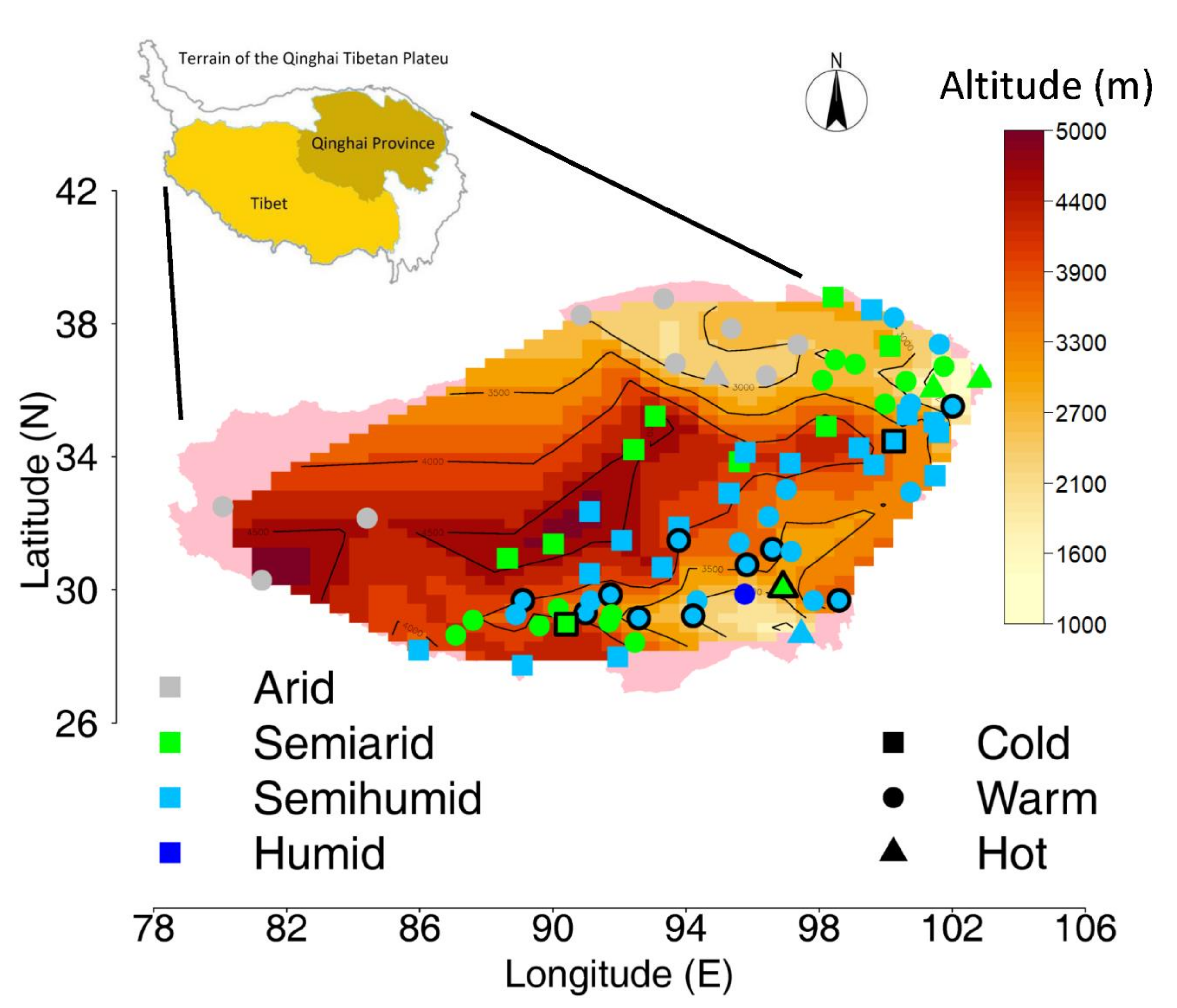

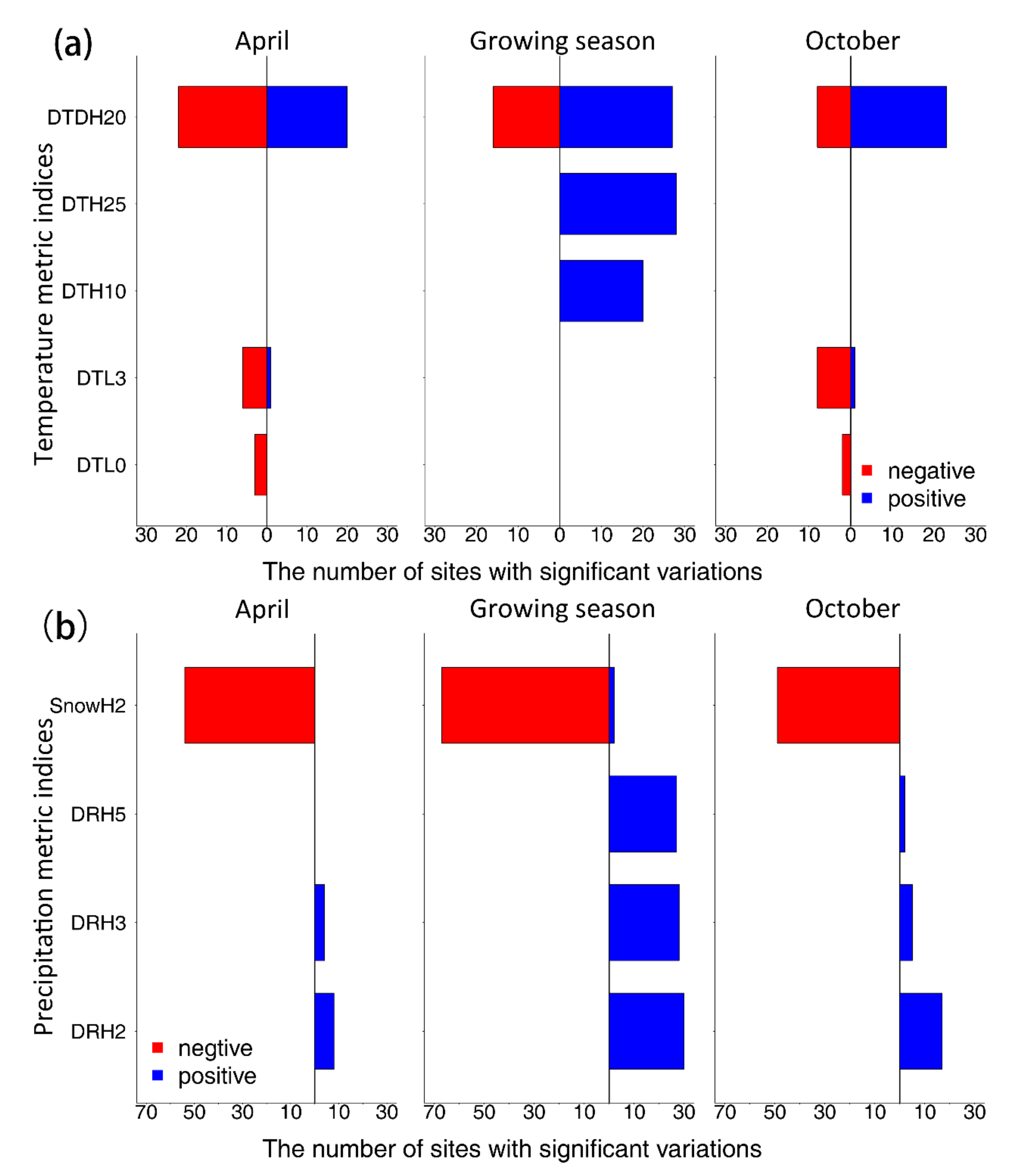
| Sites | Latitude (°N) | Longitude (°E) | Altitude (m) | Precipitation Zoning | Temperature Zoning | Missing Ratio (%) | |
|---|---|---|---|---|---|---|---|
| P | T | ||||||
| Anduo | 32.35 | 91.1 | 4800 | Semihumid | Cold | 0.19 | 0 |
| Bange | 31.38 | 90.02 | 4700 | Semiarid | Cold | 0.2 | 0 |
| Banma | 32.93 | 100.75 | 3530 | Semihumid | Warm | 0.19 | 0 |
| Basu | 30.05 | 96.92 | 3260 | Semiarid | Hot | 0.09 | 0 |
| Biru | 31.48 | 93.78 | 3940 | Semihumid | Warm | 0.09 | 0 |
| Bomi | 29.87 | 95.77 | 2736 | Humid | Warm | 0.21 | 0 |
| Chaka | 36.78 | 99.08 | 3088 | Semiarid | Warm | 0.15 | 0 |
| Changdu | 31.15 | 97.17 | 3306 | Semihumid | Warm | 0.21 | 0 |
| Chayu | 28.65 | 97.47 | 2328 | Semihumid | Hot | 0.17 | 0 |
| Cuona | 27.98 | 91.95 | 4280 | Semihumid | Cold | 0.18 | 0 |
| Dachaidan | 37.85 | 95.37 | 3173 | Arid | Warm | 0.21 | 0 |
| Dangxiong | 30.48 | 91.1 | 4200 | Semihumid | Cold | 0.2 | 0 |
| Dari | 33.75 | 99.65 | 3968 | Semihumid | Cold | 0.21 | 0 |
| Delingha | 37.37 | 97.37 | 2982 | Arid | Warm | 0.21 | 0 |
| Dingqing | 31.42 | 95.6 | 3873 | Semihumid | Warm | 0.2 | 0 |
| Dingri | 28.63 | 87.08 | 4300 | Semiarid | Warm | 0.2 | 0 |
| Dulan | 36.3 | 98.1 | 3191 | Semiarid | Warm | 0.21 | 0 |
| Gaize | 32.15 | 84.42 | 4415 | Arid | Warm | 0.16 | 0 |
| Gangcha | 37.33 | 100.13 | 3302 | Semiarid | Cold | 0.21 | 0 |
| Geermu | 36.42 | 94.9 | 2808 | Arid | Hot | 0.21 | 0 |
| Gongga | 29.3 | 90.98 | 3555 | Semihumid | Warm | 0.09 | 0 |
| Guinan | 35.58 | 100.75 | 3120 | Semihumid | Warm | 0.06 | 0 |
| Guizhou | 36.03 | 101.43 | 2237 | Semiarid | Hot | 0.21 | 0 |
| Guoluo | 34.47 | 100.25 | 3719 | Semihumid | Cold | 0.09 | 0 |
| Henan | 34.73 | 101.6 | 3500 | Semihumid | Cold | 0.21 | 0 |
| Jiacha | 29.15 | 92.58 | 3260 | Semihumid | Warm | 0.09 | 0 |
| Jiali | 30.67 | 93.28 | 4489 | Semihumid | Cold | 0.21 | 0 |
| Jiangzi | 28.92 | 89.6 | 4040 | Semiarid | Warm | 0.21 | 0 |
| Jiuzhi | 33.43 | 101.48 | 3629 | Semihumid | Cold | 0.2 | 0 |
| Langkazi | 28.97 | 90.4 | 4432 | Semiarid | Cold | 0.09 | 0 |
| Lasa | 29.67 | 91.13 | 3649 | Semihumid | Warm | 0.21 | 0 |
| Lazi | 29.08 | 87.6 | 4000 | Semiarid | Warm | 0.14 | 0 |
| Leiwuqi | 31.22 | 96.6 | 3810 | Semihumid | Warm | 0.09 | 0 |
| Lenghu | 38.75 | 93.33 | 2770 | Arid | Warm | 0.21 | 0 |
| Linzhi | 29.67 | 94.33 | 2992 | Semihumid | Warm | 0.21 | 0 |
| Longzi | 28.42 | 92.47 | 3860 | Semiarid | Warm | 0.21 | 0 |
| Luolong | 30.75 | 95.83 | 3640 | Semihumid | Warm | 0.09 | 0 |
| Maduo | 34.92 | 98.22 | 4272 | Semiarid | Cold | 0.21 | 0 |
| Mangkang | 29.68 | 98.6 | 3870 | Semihumid | Warm | 0.09 | 0 |
| Mangya | 38.25 | 90.85 | 2945 | Arid | Warm | 0.21 | 0 |
| Menyuan | 37.38 | 101.62 | 2850 | Semihumid | Warm | 0.21 | 0 |
| Milin | 29.22 | 94.22 | 2950 | Semihumid | Warm | 0.09 | 0 |
| Minhe | 36.32 | 102.85 | 1814 | Semiarid | Hot | 0.21 | 0 |
| Mozhugongka | 29.85 | 91.73 | 3804 | Semihumid | Warm | 0.09 | 0 |
| Nangqian | 32.2 | 96.48 | 3644 | Semihumid | Warm | 0.21 | 0 |
| Nanmulin | 29.68 | 89.1 | 4000 | Semihumid | Warm | 0.09 | 0 |
| Naqu | 31.48 | 92.07 | 4507 | Semihumid | Cold | 0.21 | 0 |
| Nielaer | 28.18 | 85.97 | 3810 | Semihumid | Cold | 0.18 | 0 |
| Nimu | 29.43 | 90.17 | 3809 | Semiarid | Warm | 0.16 | 0 |
| Nuomuhong | 36.43 | 96.42 | 2790 | Arid | Warm | 0.21 | 0 |
| Pali | 27.73 | 89.08 | 4300 | Semihumid | Cold | 0.21 | 0 |
| Pulan | 30.28 | 81.25 | 4900 | Arid | Warm | 0.16 | 0 |
| Qiabuqia | 36.27 | 100.62 | 2835 | Semiarid | Warm | 0.21 | 0 |
| Qilian | 38.18 | 100.25 | 2787 | Semihumid | Warm | 0.21 | 0 |
| Qingshuihe | 33.8 | 97.13 | 4415 | Semihumid | Cold | 0.21 | 0 |
| Qiongjie | 29.03 | 91.68 | 3741 | Semiarid | Warm | 0.04 | 0 |
| Qumalai | 34.13 | 95.78 | 4175 | Semihumid | Cold | 0.2 | 0 |
| Rikaze | 29.25 | 88.88 | 3836 | Semihumid | Warm | 0.21 | 0 |
| Shenzha | 30.95 | 88.63 | 4672 | Semiarid | Cold | 0.21 | 0 |
| Shiquanhe | 32.5 | 80.08 | 4279 | Arid | Warm | 0.21 | 0 |
| Suoxian | 31.88 | 93.78 | 4023 | Semihumid | Cold | 0.21 | 0 |
| Tongde | 35.27 | 100.65 | 3289 | Semihumid | Cold | 0.15 | 0 |
| Tongren | 35.52 | 102.02 | 2491 | Semihumid | Warm | 0.09 | 0 |
| Tuole | 38.8 | 98.42 | 3367 | Semiarid | Cold | 0.21 | 0 |
| Tuotuohe | 34.22 | 92.43 | 4533 | Semiarid | Cold | 0.21 | 0 |
| Wudaoliang | 35.22 | 93.08 | 4612 | Semiarid | Cold | 0.21 | 0 |
| Wulan | 36.92 | 98.48 | 2950 | Semiarid | Warm | 0.06 | 0 |
| Xiaozaohuo | 36.8 | 93.68 | 2767 | Arid | Warm | 0.2 | 0 |
| Xinghai | 35.58 | 99.98 | 3323 | Semiarid | Warm | 0.21 | 0 |
| Xining | 36.72 | 101.75 | 2295 | Semiarid | Warm | 0.21 | 0 |
| Yeniugou | 38.42 | 99.58 | 3320 | Semihumid | Cold | 0.21 | 0 |
| Yushu | 33.02 | 97.02 | 3681 | Semihumid | Warm | 0.21 | 0 |
| Zaduo | 32.9 | 95.3 | 4066 | Semihumid | Cold | 0.21 | 0 |
| Zedang | 29.25 | 91.77 | 3552 | Semiarid | Warm | 0.21 | 0 |
| Zeku | 35.03 | 101.47 | 3663 | Semihumid | Cold | 0.12 | 0 |
| Zhiduo | 33.85 | 95.6 | 4179 | Semiarid | Cold | 0.09 | 0 |
| Zhongxinzhan | 34.27 | 99.2 | 4211 | Semihumid | Cold | 0.14 | 0 |
| Zuogong | 29.67 | 97.83 | 3780 | Semihumid | Warm | 0.14 | 0 |
| Climate Factors | Index Description | Ecological Relevance | Unit | Season |
|---|---|---|---|---|
| Temperature | Daily temperature higher than 25 °C (DTH25) | The optimum temperature of alpine vegetation photosynthesis is assumed to be 25 °C on the Plateau [34]. | Day | Grow |
| Daily temperature higher than 10 °C (DTH10) | Days of daily temperature above 10 °C is related to the duration of the fast-growing season on the Plateau [29]. | Day | Grow | |
| Daily temperature lower than 3 °C (DTL3) | Decomposition activities of soil microorganisms nearly stop below 3 °C on the Plateau [34]. | Day | Apr/Oct | |
| Daily temperature lower than 0 °C (DTL0) | Available (or “effective”) soil water is assumed to be zero. Water turns into the frozen state which cannot be utilized by plants. | Day | Apr/Oct | |
| Daily temperature deviation more than 20 °C (DTDH20) | Daytime temperature (25 °C) related to vegetation photosynthesis minus night temperature (5 °C) related to the normal growth of alpine plants [29]. | Day | All | |
| Precipitation | Daily rainfall more than 2 mm (DRH2) | A summer rain event of 2 mm stimulates the activity of soil microbes in arid or semiarid ecosystems [18]. | Day | All |
| Daily rainfall more than 3 mm (DRH3) | Summer rain events of at least 3 mm are often necessary to elevate rates of carbon fixation in arid or semiarid ecosystems [18]. | Day | All | |
| Daily rainfall more than 5 mm (DRH5) | Rain events above 5 mm can effectively supplement the water of root layers in arid or semiarid ecosystems [36]. Net CO2 absorption rate rises to maximum values after 3 consecutive days of 5-mm rainfall pulses in water-limited ecosystems [37]. | Day | All | |
| Daily snow more than 2 mm (SnowH2) | Snow events above 2 mm (extreme snow) significantly alter the distribution of water and energy on the Plateau [35]. | Day | All |
| Index | April | Growing Season | October | ||||||
|---|---|---|---|---|---|---|---|---|---|
| C | W | H | C | W | H | C | W | H | |
| DTL0 | 7.1 | 2.4 | 0.0 | – | – | – | 3.6 | 2.4 | 0.0 |
| DTL3 | 7.1 | 11.9 | 0.0 | – | – | – | 17.9 | 9.5 | 0.0 |
| DTH10 | – | – | – | 46.4 | 16.7 | 0.0 | – | – | – |
| DTH25 | – | – | – | 0 | 57.1 | 80.0 | – | – | – |
| DTDH20 | 25.0 | 78.6 | 40.0 | 21.4 | 81.0 | 60.0 | 7.1 | 66.7 | 20.0 |
| Index | April | Growing Season | October | |||||||||
|---|---|---|---|---|---|---|---|---|---|---|---|---|
| A | SA | SH | H | A | SA | SH | H | A | SA | SH | H | |
| DRH2 | 0.0 | 4.3 | 14.6 | 100.0 | 20.0 | 43.5 | 41.5 | 100.0 | 0.0 | 0.0 | 39.0 | 100.0 |
| DRH3 | 0.0 | 0.0 | 9.8 | 0.0 | 30.0 | 43.5 | 36.6 | 0.0 | 0.0 | 0.0 | 12.2 | 0.0 |
| DRH5 | 0.0 | 0.0 | 0.0 | 0.0 | 20.0 | 43.5 | 36.6 | 0.0 | 0.0 | 0.0 | 4.9 | 0.0 |
| SnowH2 | 70.0 | 78.3 | 68.3 | 100.0 | 90.0 | 87.0 | 97.6 | 0.0 | 60.0 | 69.6 | 65.9 | 0.0 |
| Climate Variables | Index | Growing Season | |||||
|---|---|---|---|---|---|---|---|
| Trend | p | Trend | p | Trend | p | ||
| Temperature | DTL0 | ↑ | 0.007 | – | – | ↑ | 0.010 |
| DTL3 | Null | 0.106 | – | – | Null | 0.109 | |
| DTH10 | – | – | Null | 0.387 | – | – | |
| DTH25 | – | – | ↓ | 0.027 | – | – | |
| DTDH20 | ↓ | 0.007 | ↓ | 0.002 | Null | 0.062 | |
| Precipitation | DRH2 | Null | 0.459 | ↑ | 0.001 | Null | 0.582 |
| DRH3 | Null | 0.417 | ↑ | 0.001 | Null | 0.504 | |
| DRH5 | Null | 0.369 | ↑ | 0.001 | Null | 0.263 | |
| SnowH2 | ↑ | 0 | Null | 0.870 | ↑ | 0 | |
Publisher’s Note: MDPI stays neutral with regard to jurisdictional claims in published maps and institutional affiliations. |
© 2020 by the author. Licensee MDPI, Basel, Switzerland. This article is an open access article distributed under the terms and conditions of the Creative Commons Attribution (CC BY) license (http://creativecommons.org/licenses/by/4.0/).
Share and Cite
Guo, T. Long-Term Changes and Variability of Ecologically-Based Climate Indices along an Altitudinal Gradient on the Qinghai-Tibetan Plateau. Climate 2021, 9, 1. https://doi.org/10.3390/cli9010001
Guo T. Long-Term Changes and Variability of Ecologically-Based Climate Indices along an Altitudinal Gradient on the Qinghai-Tibetan Plateau. Climate. 2021; 9(1):1. https://doi.org/10.3390/cli9010001
Chicago/Turabian StyleGuo, Tong. 2021. "Long-Term Changes and Variability of Ecologically-Based Climate Indices along an Altitudinal Gradient on the Qinghai-Tibetan Plateau" Climate 9, no. 1: 1. https://doi.org/10.3390/cli9010001
APA StyleGuo, T. (2021). Long-Term Changes and Variability of Ecologically-Based Climate Indices along an Altitudinal Gradient on the Qinghai-Tibetan Plateau. Climate, 9(1), 1. https://doi.org/10.3390/cli9010001





